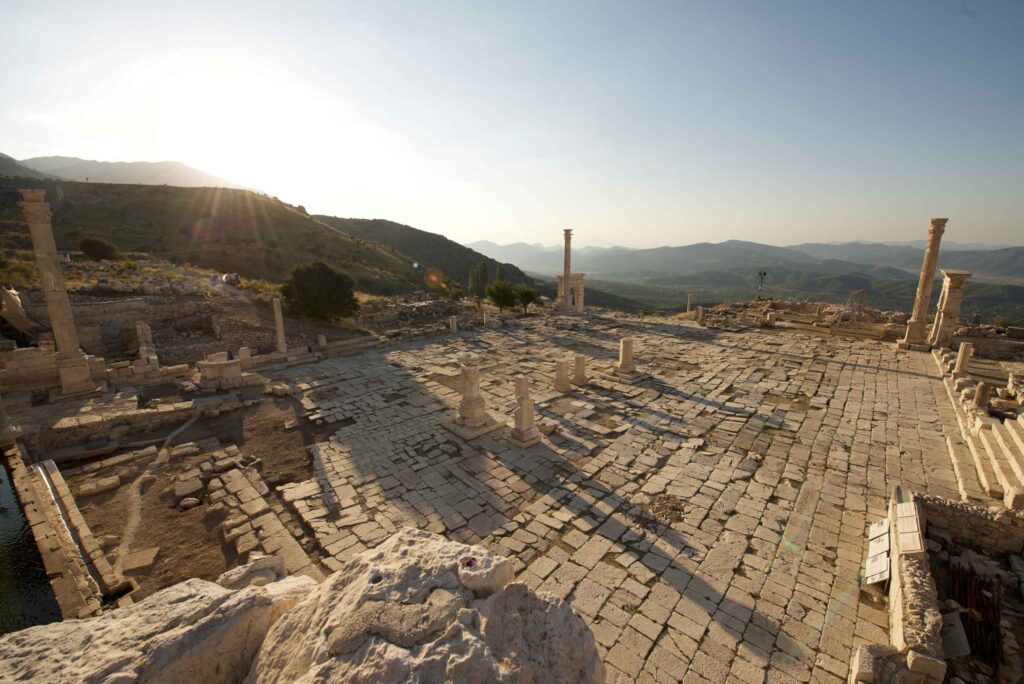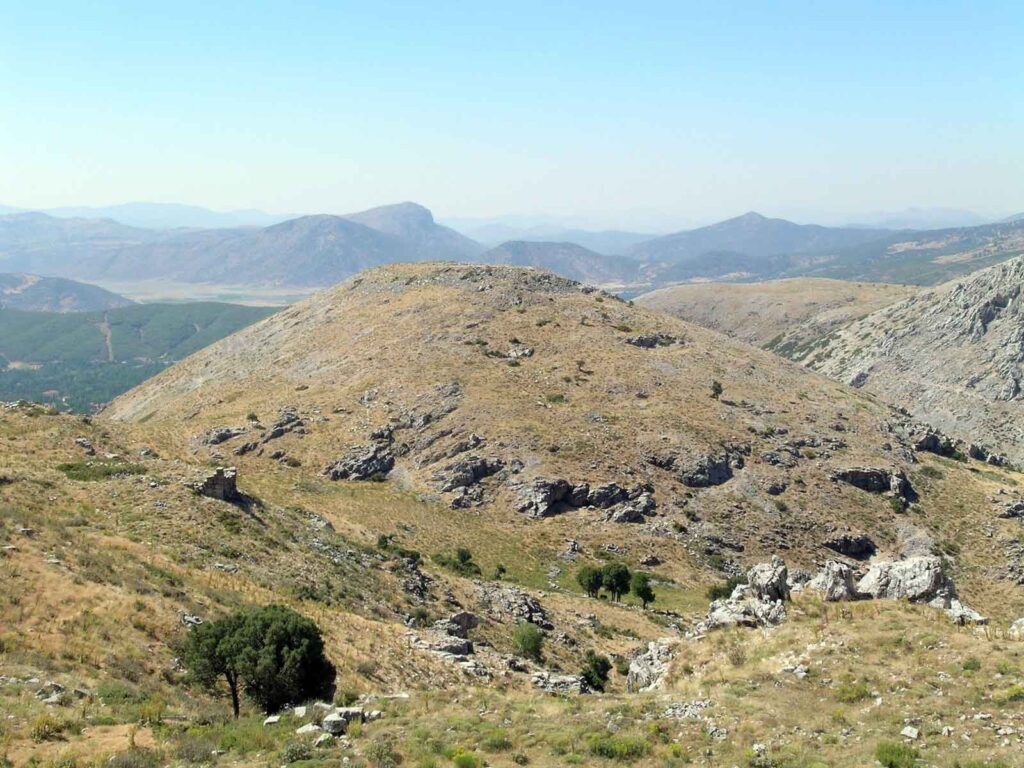
History of Sagalassos
Sagalassos was situated in ancient Pisidia, a region named after an ethnic group descendent from the Indo-European Luwians. The region of Pisidia corresponds with the present-day Lake District in the Turkish provinces of Burdur, Isparta and Antalya. Being part of the western Taurus, typical features of the Pisidian landscape are mountainous terrain, forested hills, valleys with river streams, and large plains with lakes (Figure 1).

The earliest indications of human activity in the study area are lithic artefacts that could be dated back to the Middle Palaeolithic (150,000–45,000 BP). Despite these occasional finds, the prehistory of the Burdur area is mainly known from late prehistoric mound sites in the plains, such as Hacılar and Kuruçay Höyük. All known sites from Late Neolithic and Early Chalcolithic times (6500-5500 BCE) were located in the valleys, with a clear preference for locations near fresh water sources, as well as fertile land, suggesting these locations were specifically chosen for agricultural purposes. More is known from the Late Chalcolithic and Early Bronze Age periods (4200-2000 BCE), revealing the development of a dense settlement pattern.
At Sagalassos and in its immediate hinterland, virtually no traces of occupation in this period of time have been attested. Recent material studies identified only few sherds dateable to the Iron Age period (possibly 7th-6th century BCE). The first traces of occupation at Sagalassos can be dated back to late Achaemenid times (late 5th century BCE), however direct sociocultural impact of this Persian administration on local configurations has been downplayed in recent archaeological research. At the same time of community formation at Sagalassos, traces of habitation can be found in other places throughout the Ağlasun valley. Most notably at a village located on a plateau overlooking the valley, situated about 1.8 km to the southwest of Sagalassos, at a site called Düzen Tepe, as well as a number of farms spread throughout the valley.
In 334 BCE, the Macedonian king Alexander III (later named the Great) conquered the Achaemenid Empire. According to the Roman historian Arrian, Alexander in 333 BCE took Sagalassos by storm after breaking local resistance. The settlement was described as ’not a small city’ at the time. Yet, as far as the archaeological record shows, it was probably no more than a village. As a result of Alexander’s conquest, the area of Sagalassos and Pisidia became part of the Hellenistic world. It was ruled by a series of successive dynasties after Alexander’s death, respectively the Antigonids (321-281 BCE), the Seleucids (281-188 BCE), and the Attalids (188-133 BCE). During this period, communities in the geographic area of Pisidia gradually converged into larger territories associated with a number of urban centres, such as at Termessos, Selge and Sagalassos. At Sagalassos, the territory was extended to include the fertile Burdur plain in the early 2nd century BCE at the latest, possibly as a result of Seleucid policies or stimuli. A lot of Hellenistic settlements in the area were either fortified or located at elevated positions within the landscape, suggesting a continued concern for safety rather than agricultural potential.
After the death of Attalos III in 133 BCE, the Romans reorganised most of the Attalid kingdom into provinces and client kingdoms. Following several decades of conflict, Pisidia came under the rule of Amyntas of Galatia in 36 BCE. His death in 25 BCE meant the incorporation of Pisidia into the Roman province of Galatia by the emperor Augustus.

Red Slip Ware
During the Roman Imperial period, increased construction of public buildings markedly changed the physical outlook of Sagalassos and many other cities. Local potters also started to produce a new type of fine Roman-style tablewares during the reign of Augustus, the so-called Sagalassos Red Slip Ware (SRSW) (Figure 2), which continued until the 7th century CE. The community at Sagalassos – both elite and non-elite – made good use of the opportunities offered by the Roman Empire, and the city quickly became the first city of Pisidia.
Urban expansion and building activities reached new heights under the reign of Hadrian [Figure 2] when a veritable ‘building boom’ ensued, including the Neon library, the Hadrianic nymphaeum, the Temples of Apollo Klarios and Antoninus Pius, and most notably the massive Roman Baths. Under his successors, the Baths were completed, as well as the Macellum situated between the Lower and Upper Agora (Figure 3). It is possible that the construction of the impressive theatre (Figure 4) was initiated at this time as well. The elaboration of the urban infrastructure of Sagalassos would continue well into the 3rd century CE. In the early 4th century CE, the administration of the Roman Empire was re-organized and Sagalassos lost its leading role in the area to Pisidian Antioch.


Between the middle of the 5th and the 6th century CE, amongst other buildings, nine churches were raised within the city and its periphery. Existing urban structures and features remained in use and well maintained, including the Baths complex, the city squares, porticoes and streets. From the late 6th century onwards, Sagalassos gradually attained a less urban character, as many public spaces and buildings became subdivided in several smaller units. This process of encroachment can be seen as indicative for the transformation of the urban fabric at the time.

A devastating earthquake in the 7th century CE proved to be the deathblow for many of the public buildings. The community seems to have resettled around a kastron on the plateau of the partially dismantled sanctuary of Antoninus Pius.
Ecclesiastical sources show that Sagalassos remained a bishopric of the province of Pisidia, indicating a certain degree of continuity. Occupation at the kastron continued in the Middle Byzantine period, however it is likely that the destruction of the fortress on top of Alexander’s Hill (Figure 5) in the early 13th century heralded the end of Sagalassos as an organized community. Afterwards, Sagalassos became part of the Anatolian Seljuk sultanate and occupation at the mountain slopes was abandoned in favour of the growing community in the valley bottom, which developed into the modern village of Ağlasun.
Recent publications
Documenting Ancient Sagalassos
